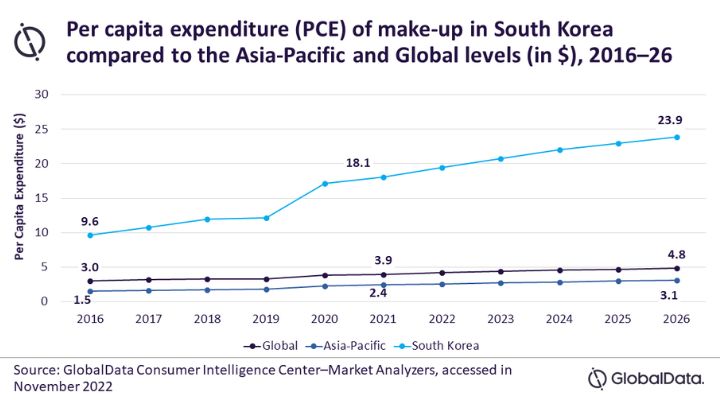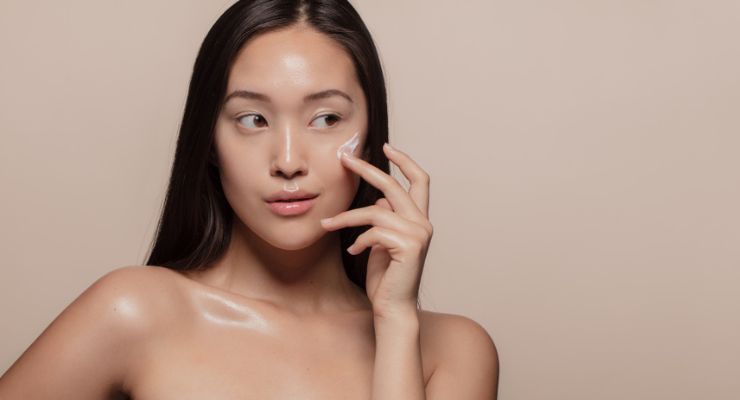01.03.23
According to GlobalData’s recent report, “South Korea Make-up - Market Assessment and Forecasts to 2026,” the South Korean makeup market is set to expand at a healthy pace in the coming years, spurred by increasing public outdoor mobility, high product innovation and rising online sales.
Moreover, a strong celebrity culture is contributing to the expansion of the consumer base, and encouraging South Korean men to embrace makeup in their beauty routines. Against this backdrop, the South Korean makeup market is projected to rise to KRW 2,827.8 million ($2.5 billion) by 2026, registering a compound annual growth rate (CAGR) of 5.5% over 2021–2026, says GlobalData.
The report also reveals that the face makeup category will register the fastest growth over the forecast period, followed by the lip makeup category.

The per capita expenditure (PCE) on makeup in South Korea increased from $9.6 in 2016 to $18.1 in 2021, surpassing the regional average of $2.4, and the global average of $3.9. South Korea’s PCE on makeup will surge to $23.9 by 2026.
Amorepacific Corporation, LG Corp, and The Estee Lauder Companies were the top three companies in the South Korean makeup market in value terms in 2021, while The Face Shop and Sulwhasoo were the leading brands. E-retailers was the leading distribution channel, followed by health & beauty stores and direct sellers.
“Going forward, the rising consumer interest in clean beauty will bolster demand for makeup products containing natural and organic ingredients that are perceived to be gentle and more effective than harsh chemicals,” Joseph concludes. “As a result, domestic and multinational manufacturers are expected to roll out innovative products with natural and sustainable ingredients with the effectiveness of regular chemical formulations. However, the emergence of new Covid-19 variants and rising inflation can derail the recovery of the South Korean makeup market in the immediate future.”
Moreover, a strong celebrity culture is contributing to the expansion of the consumer base, and encouraging South Korean men to embrace makeup in their beauty routines. Against this backdrop, the South Korean makeup market is projected to rise to KRW 2,827.8 million ($2.5 billion) by 2026, registering a compound annual growth rate (CAGR) of 5.5% over 2021–2026, says GlobalData.
The report also reveals that the face makeup category will register the fastest growth over the forecast period, followed by the lip makeup category.

South Korean Men Are Spending More on Makeup
Suneera Joseph, consumer analyst at GlobalData, says, “Spurred by Korean pop music, movie, and TV celebrity endorsements, and the availability of innovative Korean Beauty (K-Beauty) products, South Korean men are spending more on makeup products. With the authorities easing the Covid-19 restrictions in 2022, consumers began leaving their homes more often for work, studies, leisure, socializing, shopping and other activities, thereby giving rise to more occasions for applying makeup. Moreover, the increased penetration of online beauty retailers bolstered sales of cosmetics.”The per capita expenditure (PCE) on makeup in South Korea increased from $9.6 in 2016 to $18.1 in 2021, surpassing the regional average of $2.4, and the global average of $3.9. South Korea’s PCE on makeup will surge to $23.9 by 2026.
Amorepacific Corporation, LG Corp, and The Estee Lauder Companies were the top three companies in the South Korean makeup market in value terms in 2021, while The Face Shop and Sulwhasoo were the leading brands. E-retailers was the leading distribution channel, followed by health & beauty stores and direct sellers.
“Going forward, the rising consumer interest in clean beauty will bolster demand for makeup products containing natural and organic ingredients that are perceived to be gentle and more effective than harsh chemicals,” Joseph concludes. “As a result, domestic and multinational manufacturers are expected to roll out innovative products with natural and sustainable ingredients with the effectiveness of regular chemical formulations. However, the emergence of new Covid-19 variants and rising inflation can derail the recovery of the South Korean makeup market in the immediate future.”













